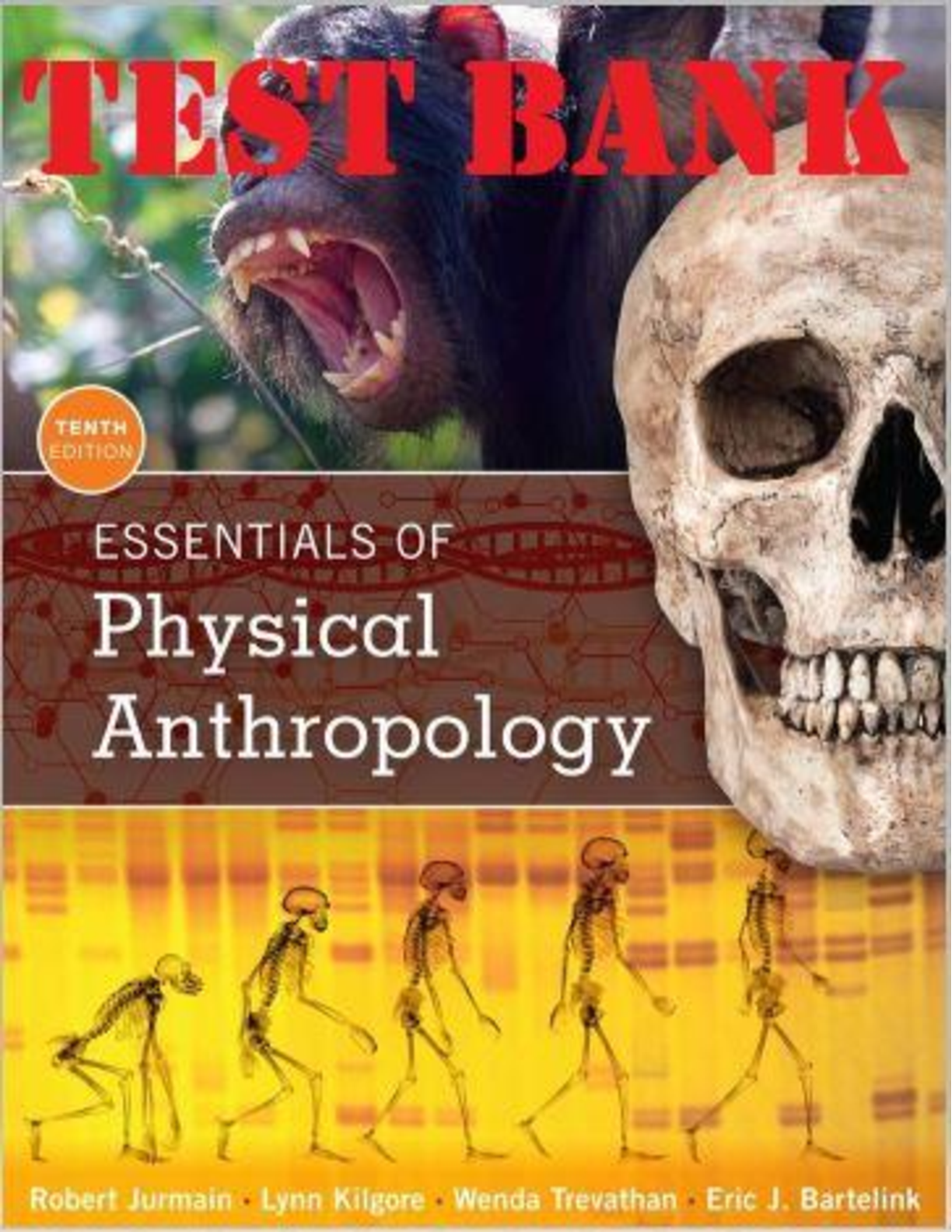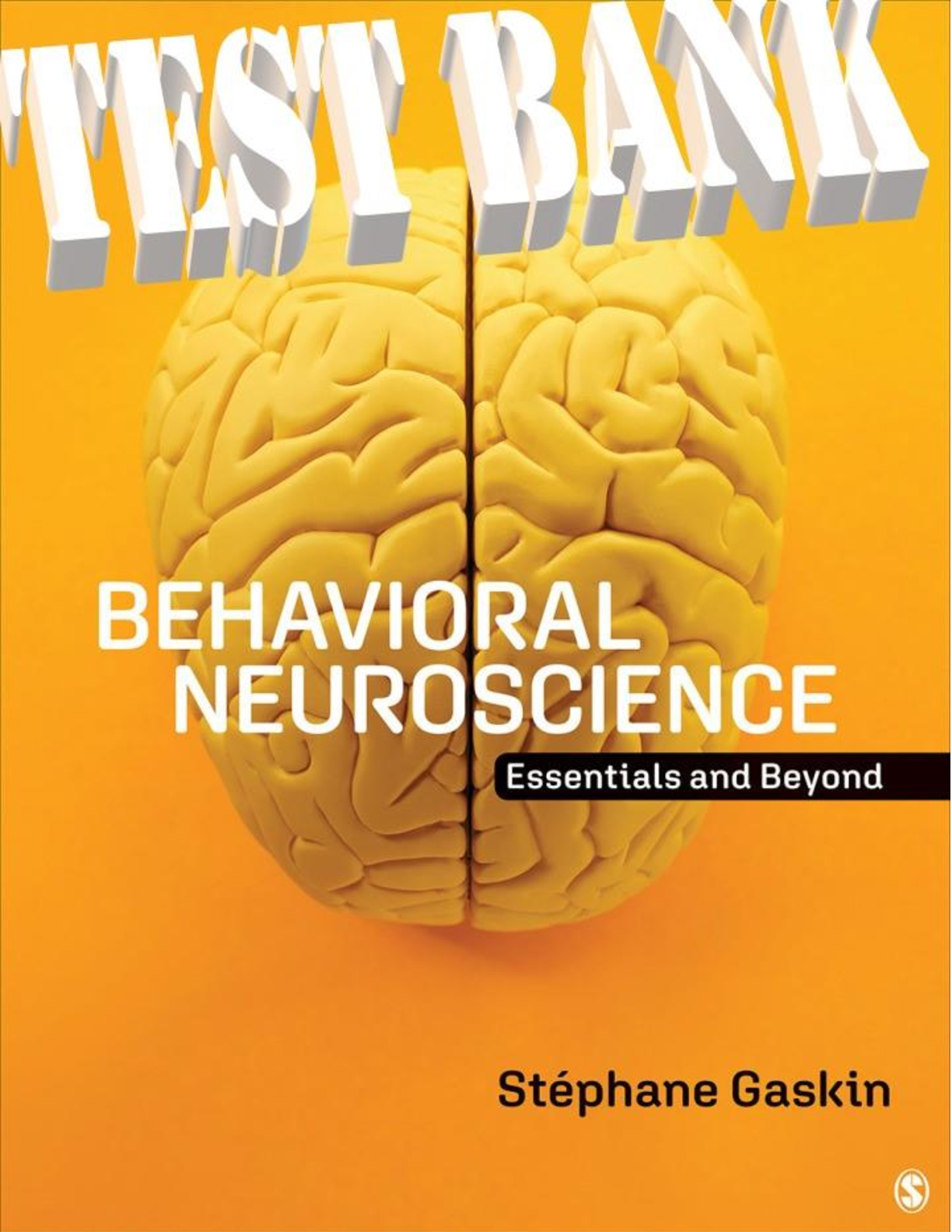Anthropology > TEST BANK > COMPLETE - Elaborated Test Bank for Essentials of Physical Anthropology 10ED.by Robert Jurmain, Lynn (All)
COMPLETE - Elaborated Test Bank for Essentials of Physical Anthropology 10ED.by Robert Jurmain, Lynn Kilgore, Wenda Trevathan & Eric Bartelink ALL Chapters included and updated for 2019
Document Content and Description Below
COMPLETE - Elaborated Test Bank for Essentials of Physical Anthropology 10ED.by Robert Jurmain, Lynn Kilgore, Wenda Trevathan & Eric Bartelink ALL Chapters included and updated for 2019 COMPLETE - E... laborated Test Bank for Essentials of Physical Anthropology 10ED.by Robert Jurmain, Lynn Kilgore, Wenda Trevathan & Eric Bartelink Ch 1: Introduction to Physical Anthropology Ch 2: The Development of Evolutionary Theory Ch 3: The Biological Basis of Life Ch 4: Heredity and Evolution Ch 5: Processes of Macroevolution Ch 6: An Overview of the Primates Ch 7: Primate Behavior Ch 8: Primate and Hominin Origins Ch 9: The First Dispersal of the Genus Homo: Homo Erectus and Contemporaries Ch 10: Premodern Humans Ch 11: The Origin and Dispersal of Modern Humans Ch 12: Human Variation and Adaptation Ch 13: Legacies of Human Evolutionary History: Effects on the Life Course Ch 14: The Human Disconnection SAMPLE QUESTIONS Chapter Outline I. Introduction A. Hominins are members of an evolutionary lineage which includes our own species, Homo sapiens, and all extinct bipedal relatives. 1. The 3.7 million year-old footprints at the ancient savanna site of Laetoli, as well as numerous fossil discoveries in Africa, are clear evidence of bipedalism. The footprints in what is now Tanzania in eastern Africa indicate the presence of Australopithecus afarensis. 2. The foot prints at the moon and the Laetoli footprints both represent humankind’s place in nature. 3. Homo sapiens are the result of the same evolutionary forces that produced all other life forms on this planet. 4. Evolution is defined as the change in the genetic structure of a population. a. Evolution can be studied at the microevolutionary or macroevolutionary level. b. It also involves the study of human variation and adaptation. II. The Human Connection A. Human beings are linked to all other life forms on earth biologically and behaviorally. 1. There is a biological continuum because we are the product of the same evolutionary forces that produced all living things. 2. There is a behavioral continuum between humans and other life forms, especially with the nonhuman primates. III. Biocultural Evolution A. Biological anthropologists are involved in the study of physiological and biological systems, yet the role of culture must also be considered. 1. Culture is the strategy by which humans adapt to the natural environment. 2. Each culture shapes people’s perceptions of the external environment, or worldview. 3. Culture is learned and not genetically determined, yet the predisposition is profoundly influenced by biological factors. The mutual, interactions between biology and culture is biocultural evolution. a. Biocultural evolution makes humans unique. b. It has resulted in many anatomical, biological, and behavioral changes during the course of human evolution. IV. What Is Anthropology? A. In the United States anthropology is divided into four main subfields: a. Cultural (or social) anthropology b. Archaeology c. Linguistic Anthropology d. Physical (or biological) anthropology e. Applied Anthropology refers to practical applications of each of these subfields B. Cultural Anthropology is the study of the patterns of belief and behavior found in modern and historical cultures. 1. Early anthropologists concentrated on producing ethnographies, but later broadened their scope to include anthropologists’ own cultures and the people around them. 2. Ethnographic techniques are now used to study diverse subcultures and their interactions with one another in contemporary metropolitan areas (urban anthropology.) Copyright © 2017 Cengage Learning. All Rights Reserved. C. Linguistic Anthropology is the study of human speech and language and different aspects of culture, such as the role of symbols in society, social identity, and cultural beliefs and ideologies. 1. Linguists examine similarities between contemporary languages to trace historical ties between languages and groups of languages. 2. The spontaneous acquisition and use of language is a uniquely human characteristic. a. Linguistic anthropology also interests physical anthropologists because it provides insights into the processes responsible for the development of language in human evolution. D. Archaeology is the study of earlier cultures and lifeways by anthropologists who specialize in the scientific recovery, analysis, and interpretation of the material remains of past societies. 1. The primary sources of information are artifacts and other material culture. 2. Archaeologists excavate in order to gain information about human behavior and in broader issues, such as the development of agriculture or the rise of cities. E. Physical Anthropology is the study of human biology within an evolutionary framework with emphasis on interaction between biology and culture. 1. Physical anthropology and biological anthropology are synonymous. a. The use of the term biological anthropology reflects a shift towards genetics, evolutionary biology, nutrition, adaptation, and growth and development through advances in genetics. b. Origins date back to 19th century “natural historians” who questioned the validity of the Bible (most significantly Charles Darwin). 2. Paleoanthropology is the subfield concerned with the study of anatomical and behavioral human evolution as revealed in the fossil record. a. Paleoanthropologists identify fossil hominin species and their evolutionary relationships and attempt to reconstruct their adaptations and behaviors. 3. Human variation was a major area of interest for early biological anthropologists. a. It was mainly concerned with the most obvious observable physical difference, skin color, body proportions and shape of the head and face. b. Today, human variation offers a perspective on adaptive significance and genetic factors of variation. c. Nutritional anthropologists study relationships between various dietary components, cultural practices, physiology, and aspects of health and disease. d. Molecular anthropologists investigate evolutionary relationships between human populations and nonhuman primates using similarities and differences in DNA. 4. Osteology is the subfield concerned with the study of the skeleton. Knowledge of the structure and function of the skeletal system is crucial for understanding the fossil record, and it forms the foundation for the analysis of archaeologically-derived human skeletal materials. a. Bioarchaeology refers to the study of human skeletal remains from archaeological sites. 5. Paleopathology focuses on the analysis of skeletal samples, noting the incidence of trauma, disease, nutritional deficiency, and any other pathological condition that leaves traces on bones. 6. Forensic anthropology is the application of archaeological and osteological techniques to legal matters. a. Forensic anthropologists help identify and analyze skeletal remains that have legal significance. b. They also aid in the identification of remains after mass disasters; the identification of the September 11 terrorist attack victims is a recent example. 7. Anatomy is an important area of interest; a thorough knowledge of soft tissue anatomy is essential to understanding the biomechanical relationships involved in movement. 8. Primatology is the subfield concerned with the study of nonhuman primate biology and behavior. Copyright © 2017 Cengage Learning. All Rights Reserved. F. Applied Anthropology 1. Applied anthropology is aimed at the practical application of anthropological theories and methods outside of the academic setting, yet it includes both academic and applied methods. a. Forensic anthropologists are a good example of the applied approach. 2. Applied approaches in biological anthropology are numerous. V. Physical Anthropology and the Scientific Method A. Science is a method for gaining information to explain natural phenomena. 1. A hypothesis is defined as a provisional explanation of phenomena. 2. The hypothesis must be tested through additional quantitative data collection and analysis. The goal is to falsify the hypothesis through empirical research. a. If the hypothesis cannot be falsified through rigorous testing, then it rises to the level of a theory; a broad statement of scientific relationships substantiated through hypothesis testing. (i) Theories are not absolute truths, since they may be disproved in light of new empirical evidence. (ii) Theories are not facts but tested explanations of facts. 3. Scientific Testing refers to the precise repetition of an experiment or expansion of observed data to provide verification; the procedure by which hypotheses and theories are verified, modified, or discarded. a. Any proposition that is stated as absolute or does not allow the possibility of falsification is not a scientific hypothesis and should never be considered as such. VI. The Anthropological Perspective A. The anthropological perspective stresses that human beings can only be understood by broadening our perspectives over space and through time. 1. By extending our knowledge to include cultures other than our own, we hope to avoid the ethnocentric bias. 2. In a relativistic view of culture, anthropologists seek information from as many different cultures in as many different ecological circumstances as possible (broadening perspective over space) as we become an increasingly interdependent global community. Key Terms and Concepts Adaptation, p. 5 Anthropology, p. 4-5 Applied anthropology, p. 11 Artifacts, p. 11 Behavior, p. 6 Bioarchaeology, p. 15 Biocultural evolution, p. 10 Bipedally, p 4-5 Continuum, p. 6 Culture, p. 6 Data, p. 19 DNA (deoxyribonucleic acid), p. 15 Empirical, p. 19 Ethnocentric, p. 21 Ethnographies, p. 11 Evolution, p. 5 Forensic anthropology, p. 16 Copyright © 2017 Cengage Learning. All Rights Reserved. Genetic, p. 5 Hominins, p. 3-4 Hypotheses, p. 19 Osteology, p. 15 Paleoanthropology, p. 12 Paleopathology, p. 16 Primates, p. 4-5 Primatology, p. 17 Quadrupedal, p. 21 Quantitatively, p. 19 Relativistic, p. 21 Savanna, p. 3-4 Science, p. 19 Scientific method, p. 19 Scientific testing, p. 20 Species, p. 3-4 Theory, p. 20 Worldview, p. 6 Lecture Suggestions 1. Discuss any previous knowledge students had about anthropology and how this changed after reading the chapter. How does anthropology address the question of what it means to be human? 2. Describe your own research interests and explain how the focus fits into the discipline of anthropology. How does it address broader anthropological questions? 3. Discuss the importance of cultural diversity today. How is culture an adaptive strategy? What examples can students suggest to this question? 4. Ask students to define culture in their own words. Compare students’ definitions to suggest ways that different backgrounds may influence how people regard themselves and their culture. 5. Compare and contrast biological and cultural evolution. What examples do students know of each of these types of change? How are they alike and different? How does each relate to the concept of adaptation? 6. Give various examples of applied anthropology projects and discuss the importance of anthropology in our world today. What current problems do students think could most benefit from an “anthropological perspective”? 7. Expand the discussion of the scientific method. Explore how most people tend to generalize from isolated events and anecdotal information. Point out that this approach differs significantly from that of data collection and hypothesis testing. 8. Explore the differences between objective and subjective data. Suggest that students track the information they receive in one hour, noting whether the information is subjective or objective. 9. Present an interesting current events item to students. Compare, evaluate, and discuss ethnocentric and relativistic viewpoints associated with the story. 10. Present several case studies in physical anthropology and ask students to evaluate what type of approach is being used (e.g., osteological, forensics, primatological, paleopathological, etc.) Internet Exercises 1. Visit the American Anthropological Association’s web site, http://www.aaanet.org/ to learn more about the discipline of anthropology. What non-academic careers are available for anthropologists? (For more on Careers in Anthropology, see the link, “Advance Your Career.”) Copyright © 2017 Cengage Learning. All Rights Reserved. 2. The official web site for the American Association of Physical Anthropology is http://physanth.org/ What careers are available to physical anthropologists? (At the link http://www.physanth.org/jobpostings you can read current academic postings in Physical Anthropology.) 3. Forensic anthropology is a growing field within physical anthropology. For more on this applied approach, see http://fac.utk.edu/forensic.html. In what areas are forensic anthropologists most commonly employed? 4. For more information on various specialties in anthropology (especially cultural, or social, anthropology), see http://www.discoveranthropology.org.uk/. Multiple Choice Questions 1. Approximately 3.7 million years ago, two or three hominins left their footprints across the savanna of modern-day Tanzania, clear evidence that: a. apes were present in Tanzania. b. hominins walked bipedally. c. modern-day Tanzania continues to be a savanna environment. d. hominins traveled in small groups. e. Tanzania is 3.7 million years old. ANS: b REF: Introduction 2. A group of reproductively-isolated organisms that can interbreed and produce fertile offspring is called a(n): a. infrastructure. b. species. c. family. d. hominid. e. populace. ANS: b REF: Introduction 3. The order Primates includes all of the following except: a. monkeys. b. prosimians. c. humans. d. tarsiers. e. marsupials. ANS: e REF: Introduction 4. What unique strategy allows humans to adapt to the natural environment? a. Evolution b. Culture c. Biological adaptation d. Walking on two legs e. Genetic change ANS: b Copyright © 2017 Cengage Learning. All Rights Reserved. REF: The Human Connection 5. The term evolution refers to: a. changes in the genetic make-up of a population from one generation to the next. b. the process of biological specialization. c. genetic changes within populations, but not the appearance COMPLETE - Elaborated Test Bank for Essentials of Physical Anthropology 10ED.by Robert Jurmain, Lynn Kilgore, Wenda Trevathan & Eric Bartelink ALL Chapters included and updated for 2019. [Show More]
Last updated: 1 year ago
Preview 1 out of 227 pages

Buy this document to get the full access instantly
Instant Download Access after purchase
Add to cartInstant download
We Accept:

Reviews( 0 )
$28.50
Document information
Connected school, study & course
About the document
Uploaded On
Mar 27, 2023
Number of pages
227
Written in
Additional information
This document has been written for:
Uploaded
Mar 27, 2023
Downloads
0
Views
62


























